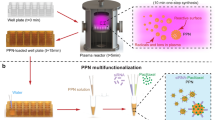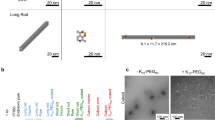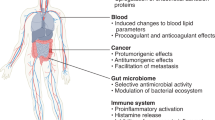Abstract
Protein affinity reagents are widely used in basic research, diagnostics and separations and for clinical applications, the most common of which are antibodies. However, they often suffer from high cost, and difficulties in their development, production and storage. Here we show that a synthetic polymer nanoparticle (NP) can be engineered to have many of the functions of a protein affinity reagent. Polymer NPs with nM affinity to a key vascular endothelial growth factor (VEGF165) inhibit binding of the signalling protein to its receptor VEGFR-2, preventing receptor phosphorylation and downstream VEGF165-dependent endothelial cell migration and invasion into the extracellular matrix. In addition, the NPs inhibit VEGF-mediated new blood vessel formation in Matrigel plugs in vivo. Importantly, the non-toxic NPs were not found to exhibit off-target activity. These results support the assertion that synthetic polymers offer a new paradigm in the search for abiotic protein affinity reagents by providing many of the functions of their protein counterparts.
This is a preview of subscription content, access via your institution
Access options
Access Nature and 54 other Nature Portfolio journals
Get Nature+, our best-value online-access subscription
$29.99 / 30 days
cancel any time
Subscribe to this journal
Receive 12 print issues and online access
$259.00 per year
only $21.58 per issue
Buy this article
- Purchase on Springer Link
- Instant access to full article PDF
Prices may be subject to local taxes which are calculated during checkout





Similar content being viewed by others
References
Hardiman, G. Next-generation antibody discovery platforms. Proc. Natl Acad. Sci. USA 109, 18245–18246 (2012).
Dubel, S., Stoevesandt, O., Taussig, M. J. & Hust, M. Generating recombinant antibodies to the complete human proteome. Trends Biotechnol. 28, 333–339 (2010).
Lollo, B., Steele, F. & Gold, L. Beyond antibodies: new affinity reagents to unlock the proteome. Proteomics 14, 638–644 (2014).
Cobaugh, C. W., Almagro, J. C., Pogson, M., Iverson, B. & Georgiou, G. Synthetic antibody libraries focused towards peptide ligands. J. Mol. Biol. 378, 622–633 (2008).
Marx, V. Calling the next generation of affinity reagents. Nat. Methods 10, 829–833 (2013).
Arkin, M. R. & Wells, J. A. Small-molecule inhibitors of protein–protein interactions progressing towards the dream. Nat. Rev. Drug Discov. 3, 301–317 (2004).
Klinger, D. & Landfester, K. Stimuli-responsive microgels for the loading and release of functional compounds fundamental concepts and applications. Polymer 53, 5209–5231 (2012).
Schild, H. G. Poly(N-isopropylacrylamide): experiment, theory and application. Prog. Polym. Sci. 17, 163–249 (1992).
Uversky, V. N., Oldfield, C. J. & Dunker, A. K. Intrinsically disordered proteins in human diseases: introducing the D2 concept. Annu. Rev. Biophys. 37, 215–246 (2008).
Rogers, J. M., Wong, C. T. & Clarke, J. Coupled folding and binding of the disordered protein PUMA does not require particular residual structure. J. Am. Chem. Soc. 136, 5197–5200 (2014).
Hoshino, Y. et al. Affinity purification of multifunctional polymer nanoparticles. J. Am. Chem. Soc. 132, 13648–13650 (2010).
Christman, K. L. et al. Nanoscale growth factor patterns by immobilization on a heparin-mimicking polymer. J. Am. Chem. Soc. 130, 16585–16591 (2008).
Oh, Y. I., Sheng, G. J., Chang, S. K. & Hsieh-Wilson, L. C. Tailored glycopolymers as anticoagulant heparin mimetics. Angew. Chem. Int. Ed. 52, 11796–11799 (2013).
Nguyen, T. H. et al. A heparin-mimicking polymer conjugate stabilizes basic fibroblast growth factor. Nat. Chem. 5, 221–227 (2013).
Dernedde, J. et al. Dendritic polyglycerol sulfates as multivalent inhibitors of inflammation. Proc. Natl Acad. Sci. USA 107, 19679–19684 (2010).
Hoshino, Y. et al. The rational design of a synthetic polymer nanoparticle that neutralizes a toxic peptide in vivo. Proc. Natl Acad. Sci. USA 109, 33–38 (2012).
Yoshimatsu, K., Koide, H., Hoshino, Y. & Shea, K. J. Preparation of abiotic polymer nanoparticles for sequestration and neutralization of a target peptide toxin. Nat. Protoc. 10, 595–604 (2015).
Koch, S. J., Renner, C., Xie, X. L. & Schrader, T. Tuning linear copolymers into protein-specific hosts. Angew. Chem. Int. Ed. 45, 6352–6355 (2006).
Lee, S. H. et al. Engineered synthetic polymer nanoparticles as IgG affinity ligands. J. Am. Chem. Soc. 134, 15765–15772 (2012).
Yoshimatsu, K. et al. Temperature-responsive "catch and release" of proteins by using multifunctional polymer-based nanoparticles. Angew. Chem. Int. Ed. 51, 2405–2408 (2012).
Robinson, C. J., Mulloy, B., Gallagher, J. T. & Stringer, S. E. VEGF165-binding sites within heparan sulfate encompass two highly sulfated domains and can be liberated by K5 lyase. J. Biol. Chem. 281, 1731–1740 (2006).
Brozzo, M. S. et al. Thermodynamic and structural description of allosterically regulated VEGFR-2 dimerization. Blood 119, 1781–1788 (2012).
Hoshino, Y. et al. Design of synthetic polymer nanoparticles that capture and neutralize a toxic peptide. Small 5, 1562–1568 (2009).
Hoshino, Y. et al. Recognition, neutralization, and clearance of target peptides in the bloodstream of living mice by molecularly imprinted polymer nanoparticles a plastic antibody. J. Am. Chem. Soc. 132, 6644–6645 (2010).
Richard, B., Swanson, R. & Olson, S. T. The signature 3-O-sulfo group of the anticoagulant heparin sequence is critical for heparin binding to antithrombin but is not required for allosteric activation. J. Biol. Chem. 284, 27054–27064 (2009).
Ye, S. et al. Structural basis for interaction of FGF-1, FGF-2, and FGF-7 with different heparan sulfate motifs. Biochemistry 40, 14429–14439 (2001).
Guimond, S., Maccarana, M., Olwin, B. B., Lindahl, U. & Rapraeger, A. C. Activating and inhibitory heparin sequences for FGF-2 (basic FGF). Distinct requirements for FGF-1, FGF-2, and FGF-4. J. Biol. Chem. 268, 23906–23914 (1993).
Manning, G. S. Counterion binding in polyelectrolyte theory. Acc. Chem. Res. 12, 443–449 (1979).
Quesada-Perez, M., Callejas-Fernandez, J. & Hidalgo-Alvarez, R. An experimental test of the ion condensation theory for spherical colloidal particles. J. Colloid Interface Sci. 233, 280–285 (2001).
Manning, G. S. The critical onset of counterion condensation: A survey of its experimental and theoretical basis. Ber. Bunsen. Phys. Chem. 100, 909–922 (1996).
Popov, A. & Hoagland, D. A. Electrophoretic evidence for a new type of counterion condensation. J. Polym. Sci. Pol. Phys. 42, 3616–3627 (2004).
Manning, G. S. Counterion condensation on charged spheres, cylinders, and planes. J. Phys. Chem. B 111, 8554–8559 (2007).
Graells, J. et al. Overproduction of VEGF165 concomitantly expressed with its receptors promotes growth and survival of melanoma cells through MAPK and PI3K signaling. J. Invest. Dermatol. 123, 1151–1161 (2004).
Munoz, E. M. & Linhardt, R. J. Heparin-binding domains in vascular biology. Arterioscl. Throm. Vas. 24, 1549–1557 (2004).
Warkentin, T. E. et al. Heparin-induced thrombocytopenia in patients treated with low-molecular-weight heparin or unfractionated heparin. N. Engl. J. Med. 332, 1330–1336 (1995).
Karamysheva, A. F. Mechanisms of angiogenesis. Biochemistry (Mosc.) 73, 751–762 (2008).
Carmeliet, P. & Jain, R. K. Angiogenesis in cancer and other diseases. Nature 407, 249–257 (2000).
Brekken, R. A. et al. Selective inhibition of vascular endothelial growth factor (VEGF) receptor 2 (KDR/Flk-1) activity by a monoclonal anti-VEGF antibody blocks tumor growth in mice. Cancer Res. 60, 5117–5124 (2000).
Acknowledgements
Financial support from the University of California Cancer Research Coordinating Committee and the National Science Foundation (DMR-1308363) is gratefully acknowledged. This research was also supported by a Grant-in-Aid for JSPS Postdoctoral Fellowships for Research Abroad (25-426), Grant-in-Aid for MEXT (23111716 and 25107726), Grant-in-Aid for Young Scientists (A) (23685027), The Kurata Memorial Hitachi Science and Technology Foundation and The Uehara Memorial Foundation. We thank T. Ozeki for help with QCM measurements.
Author information
Authors and Affiliations
Contributions
H.K., K.Y., K.J.S., Y.H., N.O. and Y.M. designed the research and H.K. and Y.H. designed the experiments. Y.H., Y.N., and Y.M. synthesized GlcNAc monomers. H.K, K.Y., A.W., S.-H.L. and Y.Y. performed the binding assay with QCM and synthesized NPs. Y.N. took TEM pictures of the NPs. H.K., A.O. and S.A. preformed the in vitro assay with supervision from N.O.; H.K., K.Y., Y.M., Y.H., N.O. and K.J.S. wrote the manuscript. All authors discussed the results and commented on the manuscript.
Corresponding authors
Ethics declarations
Competing interests
The authors declare no competing financial interests.
Supplementary information
Supplementary information
Supplementary information (PDF 6226 kb)
Rights and permissions
About this article
Cite this article
Koide, H., Yoshimatsu, K., Hoshino, Y. et al. A polymer nanoparticle with engineered affinity for a vascular endothelial growth factor (VEGF165). Nature Chem 9, 715–722 (2017). https://doi.org/10.1038/nchem.2749
Received:
Accepted:
Published:
Issue Date:
DOI: https://doi.org/10.1038/nchem.2749
This article is cited by
-
Synthetic hydrogel nanoparticles for sepsis therapy
Nature Communications (2021)
-
Emerging functional materials based on chemically designed molecular recognition
BMC Materials (2020)
-
Complex polymer architectures through free-radical polymerization of multivinyl monomers
Nature Reviews Chemistry (2020)
-
Enhanced mechanical properties and thermal stability of cellulose insulation paper achieved by doping with melamine-grafted nano-SiO2
Cellulose (2018)



